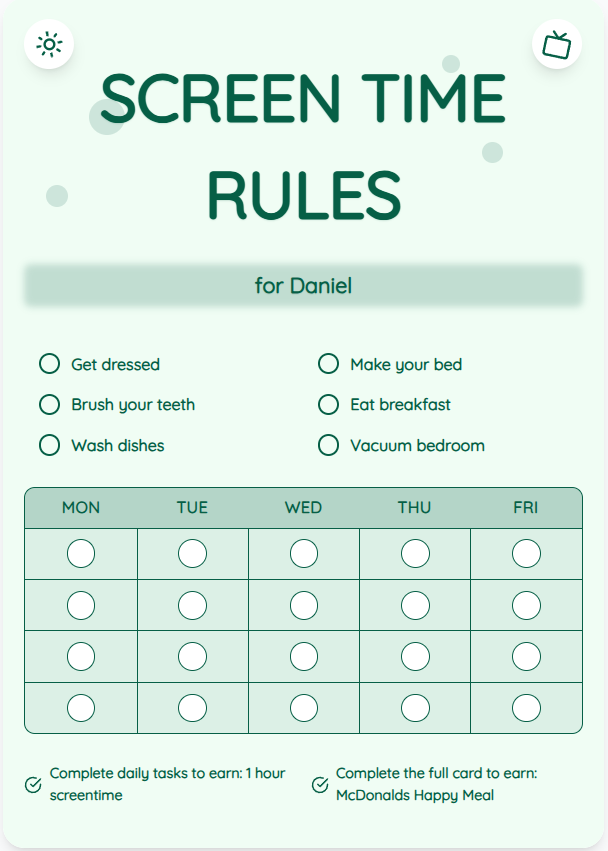Why Are Screen Time Limits Not Working? Understanding and Solutions for Parents
As a parent, you may have implemented screen time limits for your children but found them ineffective. Understanding why this happens is crucial to finding practical solutions that work for your family. In this guide, we explore common reasons why screen time limits fail and provide actionable advice to help you manage your child's screen time more effectively.
See What Your Screen Time Chart Will Look Like
Here's an example of a beautiful, customizable screen time rules chart you can create for your family

Lack of Consistency in Enforcement
One common reason why screen time limits may not work is the lack of consistency in enforcing them. Children thrive on routine and clear boundaries. If rules are not consistently applied, kids may push the limits or become confused about expectations.
Unrealistic Expectations
Setting unrealistic screen time limits that do not align with your child's age, interests, and daily schedule can lead to frustration and resistance. It's essential to set reasonable expectations based on your child's individual needs.
Put These Tips Into Action
Create a custom chart to implement these strategies with your child
Limited Alternative Activities
If children have limited engaging alternative activities, they may turn to screens out of boredom. Encouraging hobbies, outdoor play, reading, and creative pursuits can help reduce screen time dependence.
Screen Time as a Reward or Babysitter
Using screen time as a reward for good behavior or as a babysitting tool can undermine the effectiveness of limits. It's important to promote healthy screen habits as part of everyday life rather than a special treat or substitute for parental engagement.
Practical Tips for Success
- Involve your child in setting screen time limits to increase their buy-in and cooperation.
- Create a visual screen time chart using ScreenTimeRules.com to make limits clear and tangible.
- Establish tech-free zones or times in your home to reduce overall screen exposure.
- Model healthy screen habits by limiting your own screen time and engaging in other activities.
Frequently Asked Questions
How can I make screen time limits more effective?
To make screen time limits more effective, involve your child in the process, set realistic expectations, offer engaging alternatives, and avoid using screens as rewards or distractions.
What if my child resists the screen time limits?
If your child resists screen time limits, stay consistent, explain the reasons behind the limits, and offer appealing non-screen activities to encourage compliance.
Is it okay to use screen time as a reward?
Using screen time as a reward can undermine the effectiveness of limits and promote an unhealthy relationship with screens. It's best to incorporate screen time in moderation as part of daily routines.
How can I monitor my child's screen time without constant supervision?
You can monitor your child's screen time by using parental control apps, setting timers on devices, and having open conversations about responsible screen use.
Effective screen time management requires understanding the reasons behind ineffective limits and implementing practical solutions that support your child's development. By incorporating these tips and strategies into your family routine, you can create a balanced approach to screen time that promotes healthy habits and family harmony. Visit ScreenTimeRules.com to create personalized screen time charts that support your efforts.
Ready to Transform Your Family's Screen Time?
Join thousands of parents who have successfully managed screen time with our customizable charts.
